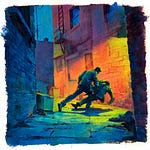She had a slate-gray Staffy with a priestly white collar. It pranced across the road and she followed wearing a matching stone tracksuit and chunky white hi-tops. They were a perfect match. They had transcended simple dog-and-its-owner going for a walk; she had arranged them both into a work of art. I’m certain it was no accident. Then again, beauty isn’t an accident either.
We think beauty is in the eye of the beholder. I call bollocks. How boring to say each of us just decide what is beautiful and what is not, as though beauty couldn’t be shared, as though it were random chance. Yes, don’t yuck anyone’s yum, and yes, I’ll never understand why some people adore abstract expressionism, but there’s a reason flowers and music and green forests are universally admired. There can be no other reason they are universally admired than some underlying rule governing the perception of beauty. Otherwise, it wouldn’t be everywhere.
And beauty is abundant. I shed a manly tear reading David Whyte’s Consolations when he writes “beauty is the harvest of presence.” From where I live in Sydney, I look across the skyline and see the UTS Tower, an infamously hideous brutalist building that straggles behind the rest of Sydney’s CBD like an ugly duckling. Rudely, they erected it right next to one of Sydney’s loveliest buildings, the Green Tower.
Yet when the sun is setting on a clear evening, it comes into its own. The clean lines, harsh and divisive during the day, neatly divide the light and shadow to cast dramatic gradations of color across its surface. The gross brown render burnishes into bronze and the tower looks like it’s about to burst into flames. It’s like a bronze sail floating away. I’m not certain this was the intention of the architect Michael Dysart, but here I am, waxing poetic. I hope it’s a clear evening tonight.
I think this is what Whyte means; the world is so dotted with patterns, connections and synchrony, and our brains are so hardwired to find them, that beauty is kind of inevitable. So let’s perform a brief philosophical extraction on beauty so we can have more of it. And who doesn’t want that?
Objectively, Beautifully
When you read this blog, you aren’t reading the first draft. Trust me, you’d know. The sentences don’t flow initially. My word choice is uninspiring. The ideas just kind of splash out on the page, with no pleasing steps between my chain of thought. When I start writing, there’s an end-state in my head that I want this to resemble as closely as possible, and it takes work to get there. This blog, for example, I actually started last year. It was trash. I wrote four turgid paragraphs and moved on. Then, I saw the woman and her staffy and voila, here we are.
The fact that I have to iterate should tell you that there is an objective component to beauty. Making beautiful things is often a search for simplicity and elegant refinement of ideas. Scientists yearn for elegance. Newton’s laws of motion got us to the moon. Then Einstein expanded our understanding of Newton’s laws with E=MC squared. Darwin’s theory of evolution is simple, yet somehow manages to explain the extraordinary rich and universal processes of life. With a mere twenty-six character alphabet, we’re able to think and explain everything we’ve ever known. Eight notes make every song you’ve ever heard. Beauty is at once breathtakingly simple and universal.
The refinement of ideas means that our world can get more beautiful with their realisation. Even if you enjoy opera and I enjoy abstract expressionism, both these artforms have emerged from millennia of iteration. Opera has been around for hundreds of years; as an artform, it’s still sung in Italian and goes in three parts. Yet when I saw Madame Butterfly a couple of years ago, it had received a facelift the aristocrats of yore could never enjoy - subtitles on a big screen, a dynamic set, all staged in the magnificent Sydney Opera House. What a time to be alive.
And even if abstract expressionism seems like pointless splashings of paint, it still represents something definitely progressive about how humans see themselves in the world. Artists like Jackson Pollock were doing something renaissance artists were never allowed to do, and imbued his painting with the expression of his emotions directly to the canvas. The canvas, rather than being mere representation, is brought to life with the artist’s feelings. It seeks to evoke.
You might disagree. I won’t yuck your yum. You might even be right. But the actual form and content of art, of what we perceive as beauty, has evolved from earlier, more primitive substrates and exploded with additions like cinema, photography and digital art. What’s more, the technical and philosophical underpinnings of these artforms have objectively improved, all the while bringing us closer to the world itself. This isn’t just me saying so - our brains are built for this process.
Mirror, mirror
In your brain are mirror neurons. One of the most startling things about being a human being is that our intelligence does not arrive from some great capacity for cogitating - although we do have that - but from our ability to copy. Humans, it turns out, are such good copiers that we can imagine what it is to be something else. We could call it empathy, but empathy isn’t a powerful enough word. While a monkey can raise an arm in imitation, a human being can imagine why the arm is being raised, and from this thought learn all sorts of things about the universe.
We call this pyschological development stage ‘theory of mind’, but it goes for things without minds, too; one can watch someone swing a sword about, imagine a sword being an extension of one’s arm - it’s heft, its balance, the feel of its grip - and start swinging it about ourselves. By repeatedly copying these patterns, and feeling how a sword moves through the air, we get a master swordsman, who is intuitively fused with this particular property of the universe. For a slightly grosser example of our intuitive fusion with the non-human world, look at any surface around you right now; I bet you can predict with alarming accuracy what that surface would feel like on your tongue.
Your brain ceaselessly imagines what the world must be like, and uses this imagination to replicate it in its own image. This isn’t just me philosophising; what sets human toddlers apart from our hairier primate cousins is their ability to learn - ie. mirror - from the people around them, a capacity which gifts us the chance to be closer with the world. Our brain goes inside things, thirstily and compulsively drawing together patterns in the matrix and starts telling stories about the world. The brutalist sail of UTS tower? A metaphor my brain created one evening. I made it up, and it pleased me because making associations is a pleasurable pasttime.
Evolutionarily speaking, mirror neurons helped our ancestors learn about patterns like buffalo migrations and the signs of a thunderstorm. Language helps us get deeper into the nature of things by creating a symbolic order to describe it with, a universal order with which to reflect the world back at itself. In modern times, with less danger around, our mirror neurons have time to look at less urgent, more interesting and pleasurable things. Perhaps that’s why some humans, blessed with comfort and the luxury of time, try and replicate beauty in art and science.
Nature, You, and Romance
No man is its enemy. It accepts whatsoever befalls, as part of its lesson. It is a watcher more than a doer, and it is a doer, only that it may the better watch.
- Emerson, Nature
Johann Wolfgang Goethe became a sensation in 18th Century Germany with his book, The Sorrows of Young Werther, in which the protagonist, restless in spirit and in love with a woman called Charlotte, kills himself when he realises his love will be unrequited. Such was the book’s sensation that hundreds of romantic young men committed suicide in imitation of Young Werther’s heartbreak, dramatically ushering in art and beauty’s most flamboyant era, the Romantic. Writing from early America at the sunset of romance’s excesses, Ralph Emerson reflected on this temporary madness. One’s emotions weren’t enough, he thought. It is a bit silly to commit suicide just because someone doesn’t like you, if for no other reason than life is full of hardships that add to its depth and richness. Emotion without reflection is like a drum without a skin. It’s the ceaseless whining of emo music - all emoting, no growing.
The fix, Emerson suggested, was to see that the great human drama of ecstasy and pain was within us and also out there, in nature. The magic of a buttery yellow sunflower inspired Van Gogh to paint something totally unique that emerged from him and started a movement we call the impressionists. He saw beauty in starry nights, sunflowers, and even his own bedroom, and committed to paint them as he saw them, the nexus between the world and him forming a kind of unity in his work.
An astonishing truth emerges here; Van Gogh’s paintings are really just the universe expressing itself, to itself. Vincent himsself didn’t come into the universe out of nothing; he came out of it like a leaf on a tree. There’s nothing about him that didn’t already exist in some matter. Atoms didn’t burst out of the ether to make him; they simply rearranged themselves. No cells emerged when the zygote that would be Vincent was formed; they split and multiplied from a sperm and an egg. And then, when they had divided to a sufficiently complex form, he came, ready to go, from his mum, out into the world with some paint brushes tucked under his arm.
So actually, since we are the universe - albeit in its own unique, idiosyncratic form - beauty might just be how the world appreciates its own elegance. A mutual loving of oneself. How simple. How marvelous. The thing-in-itself dances to its own tune, feeling the reverberations and calling them beautiful.
The Harvest of Presence
So, beauty is everywhere, and as a human you’re uniquely suited to appreciating and replicating it. That’s the good news. The bad news is that we have an in-built mechanism for ignoring it called thinking. Because mirror neurons require focus to work, you need to be present, locked-in to experience this harmony. There’s no room to make connections when you’re worrying about your 10.30. There’s no room for the world when you reach for your phone. You are denying your brains natural desire to understand and embed itself in reality.
Goethe later expressed regret for The Sorrows of Young Werther, seeing it as an artifact from the ‘calamities of a particular time.’ His play Faust (from which we get the bargain) refined his youthful ideas about passion and lust. Faust, instead of succumbing to his passions, strives to learn as much as he can about the world in an endless quest for knowledge. He makes a deal with the devil that if he should ever find peace and contentment on earth, Mephistopholes will take his soul. In the final part, published the year of Goethe’s own death, Faust does die. He feels his striving wane, sees eternal peace opening before him, and drops dead. But as Mephistopholes reaches for his soul, God intervenes, whisking Faust to heaven as reward for his noble striving, the harvest of his singular moment of presence.
Because art isn’t beauty, and beauty isn’t art. I don’t even think we can say exactly what beauty is, other than it needs a conscious creature to see and marvel at it. You are that conscious creature. Your mind is casting about for connection, and when it does find it, we call that beauty. You can choose to see that beauty is in the eye of the beholder because it exists, objectively, subjectively, entirely within you. And a woman, with her dog.






















Share this post